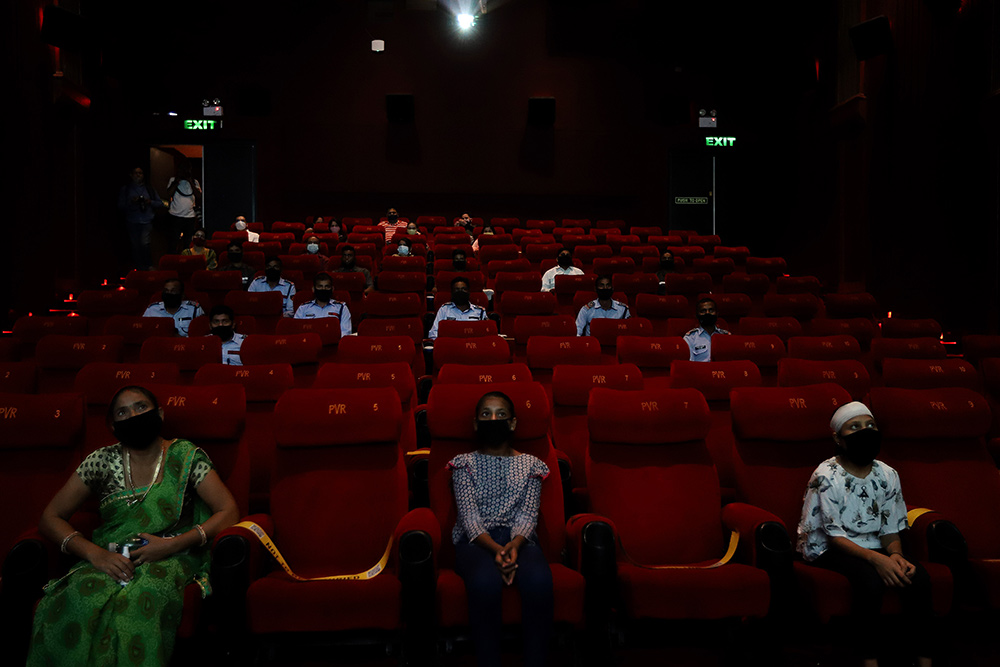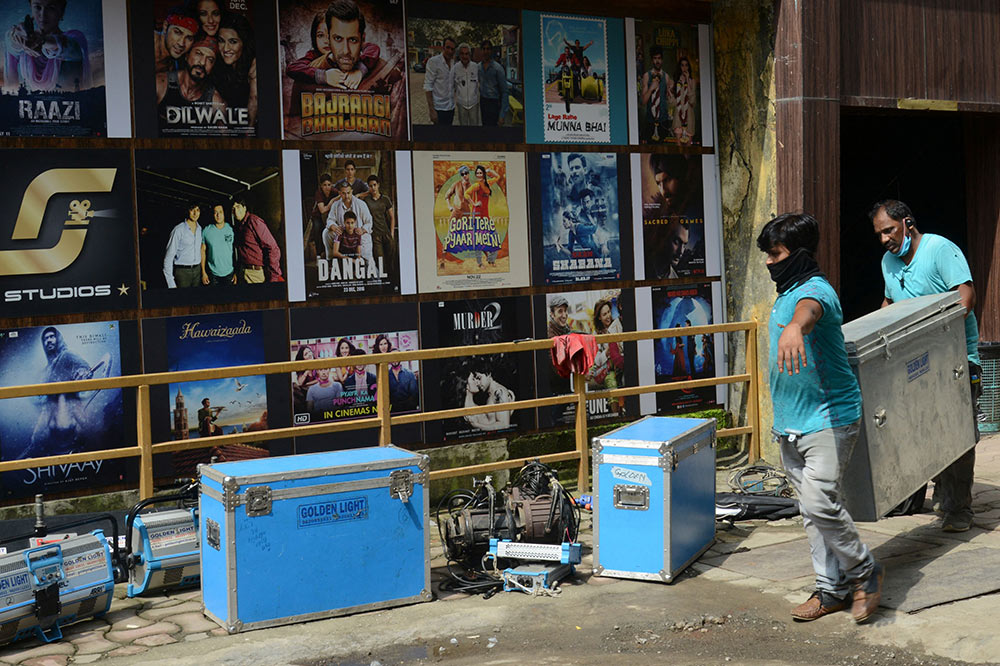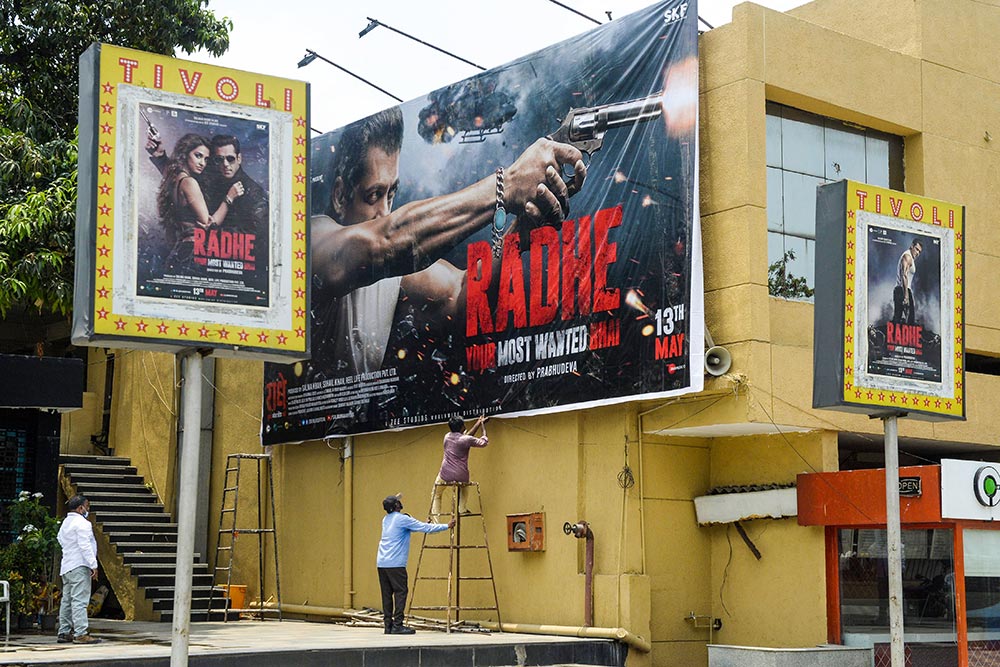位于印度孟買的寶萊塢(Bollywood)代表著價(jià)值25億美元的印地語(yǔ)電影產(chǎn)業(yè),。一部大型寶萊塢制片廠電影的成功,在很大程度上取決于影院的觀眾,,因?yàn)樗麄冐暙I(xiàn)了電影的大部分收入,。影迷表示,寶萊塢出品的歌舞片時(shí)長(zhǎng)一般在三小時(shí)左右,,最適合的觀影方式是集體觀看——在電影院里與其他觀眾一起歌唱,、歡笑、鼓掌或者哭泣,。
小說(shuō)《孟買:欲望叢林》(Maximum City: Bombay Lost and Found)的作者蘇科圖·梅塔為《紐約時(shí)報(bào)》(New York Times)撰寫了一篇文章,,講述了他對(duì)于去影院觀看寶萊塢電影這種體驗(yàn)的熱愛(ài)?!拔覟槭裁聪矚g寶萊塢電影,?對(duì)一個(gè)印度人來(lái)說(shuō),這就像問(wèn)我們?yōu)槭裁磹?ài)自己的母親,;我們別無(wú)選擇,。我們可以直接跟銀幕上的人物對(duì)話、拍手,、吹口哨或者發(fā)出嘲笑,,特別高興的時(shí)候,,還能夠扔硬幣來(lái)表示對(duì)電影的喜愛(ài)?!庇《鹊碾娪霸号c世界其他地方不同,,因?yàn)槠渌蠖鄶?shù)影院都要求觀眾盡量保持安靜。
受新冠肺炎疫情的影響,,印度各地的電影院紛紛停業(yè),,電影制作也不得不暫停。影迷們被迫留在家中,,轉(zhuǎn)而通過(guò)網(wǎng)絡(luò)進(jìn)行娛樂(lè)消費(fèi),。PVR Pictures旗下有著印度最大的連鎖院線。該集團(tuán)的首席執(zhí)行官卡邁勒·吉安昌尼表示,,2020年,,印度院線的收入驟降至3.77億美元,相比2019年的19億美元下降了80%,。
過(guò)去的18個(gè)月引發(fā)了一場(chǎng)辯論——印度的電影和觀眾是否會(huì)重返院線,,寶萊塢的未來(lái)是否會(huì)被降級(jí)到個(gè)人設(shè)備上等等,。新德里Diorama國(guó)際電影節(jié)(Diorama Film Festival)的聯(lián)合創(chuàng)始人,、電影及廣告制作公司India Shoots的創(chuàng)始人庫(kù)納爾·斯里瓦斯塔瓦指出,大多數(shù)行業(yè)分析師都希望觀眾可以回歸影院,,因?yàn)閭鹘y(tǒng)的寶萊塢觀影體驗(yàn)“不可能在手機(jī)或家庭電視屏幕上實(shí)現(xiàn)”,。
同時(shí),該行業(yè)也無(wú)法阻止新數(shù)字消費(fèi)趨勢(shì)的發(fā)展,。Viacom18 Studios的首席運(yùn)營(yíng)官阿吉特·安德黑爾認(rèn)為,,數(shù)字消費(fèi)趨勢(shì)“將繼續(xù)存在并不斷發(fā)展”,意味著寶萊塢將不得不同時(shí)擁抱大銀幕和小屏幕,。
寶萊塢對(duì)抗新冠肺炎疫情
對(duì)寶萊塢來(lái)說(shuō),,2020年是艱難的一年。電影院在這一年的大部分時(shí)間里都是關(guān)閉的,。2020年的首部寶萊塢影片《塔納吉:無(wú)名勇士》(Tanhaji: The Unsung Warrior)于1月在影院首映,,取得了5200萬(wàn)美元的票房收入,也是2020年的票房冠軍——這一年在影院上映的電影數(shù)量很少,。2019年的寶萊塢電影票房冠軍是Yash Raj Films出品的動(dòng)作片《寶萊塢雙雄之戰(zhàn)》(War),。該片由巨星赫里尼克·羅斯?jié)h領(lǐng)銜主演,總票房達(dá)6700萬(wàn)美元,。2020年3月,,印度政府針對(duì)疫情實(shí)施了為期兩個(gè)月的全國(guó)性封鎖措施。但此后,,電影院又繼續(xù)停業(yè)達(dá)六個(gè)月的時(shí)間,。政府首先放松了對(duì)基本服務(wù)的限制;影院復(fù)工則是次要事項(xiàng)。

疫情關(guān)停了電影的拍攝制作,,更打擊了該行業(yè)的盈利能力,。阿莉雅·布哈特、迪皮卡·帕度柯妮和卡特莉娜·卡芙等最具商業(yè)價(jià)值的明星均感染了新冠肺炎(并已經(jīng)康復(fù)),。片場(chǎng)的技術(shù)人員,、化妝師、背景舞者和初級(jí)演員等日薪制工作人員受到的影響最為嚴(yán)重,。由于政府未能提供相關(guān)援助,,Netflix等公司以及薩爾曼·汗等明星均承諾要為該群體提供資金支持。
2020年全年,,寶萊塢只發(fā)行了441部電影,,而其2019年的發(fā)行量達(dá)1833部。同時(shí),,寶萊塢2020年影院觀眾的數(shù)量下降了73%,,僅為3900萬(wàn),前一年則為14.6億,。咨詢公司安永(EY)的報(bào)告《2020年印度媒體和娛樂(lè)》(India 2020 Media and Entertainment)指出,,多達(dá)1500家單銀幕影院(每次只放映一部電影的影院)已經(jīng)永久停業(yè),印度全國(guó)僅余8000塊大銀幕,。多廳影院也遭受了重創(chuàng),,但轉(zhuǎn)向其他業(yè)務(wù)(比如舉辦私人放映或現(xiàn)場(chǎng)活動(dòng),以及實(shí)施掃描二維碼訂購(gòu)食品等新措施)對(duì)此類影院來(lái)說(shuō)則更加容易,。
羅伊·卡普爾電影公司(Roy Kapur Films)的創(chuàng)始人,、印度制片人協(xié)會(huì)(Producers Guild of India)的主席悉達(dá)斯·羅伊·卡普爾稱:“很多(規(guī)模較小的)單銀幕電影院沒(méi)有大公司的資助,不得不停業(yè)或出售給大型企業(yè),。這是一個(gè)零和游戲,,因?yàn)槟阋撮_(kāi)放,要么不開(kāi)放,?!彼f(shuō),很多單銀幕影院都倒閉了,,無(wú)力負(fù)擔(dān)租金,、維護(hù)費(fèi)用和工人工資。
隨著第一波疫情的消退,,印度政府在去年10月給電影院開(kāi)了綠燈,,但只允許50%的上座率,。斯里瓦斯塔瓦表示,第一輪封鎖結(jié)束后,,印度有“大量的觀眾重返影院”,。這種反彈也喚起了電影行業(yè)的信心,堅(jiān)信觀眾會(huì)回到影院觀影,。

轉(zhuǎn)向流媒體平臺(tái)
電影院長(zhǎng)達(dá)數(shù)月的停業(yè),,讓消費(fèi)者轉(zhuǎn)向了在線娛樂(lè),。Viacom18 Studios的安德黑爾指出:“對(duì)流媒體來(lái)說(shuō),這場(chǎng)疫情無(wú)疑是一個(gè)‘黑天鵝事件’,,流媒體的業(yè)務(wù)量出現(xiàn)了大幅增長(zhǎng),。”
印度現(xiàn)在共有約4000萬(wàn)用戶訂閱了一個(gè)或多個(gè)流媒體平臺(tái),,這一數(shù)據(jù)自疫情開(kāi)始以來(lái)增長(zhǎng)了40%,。(這還不包括那些通過(guò)流量捆綁套餐獲取內(nèi)容訂閱服務(wù)的消費(fèi)者,該群體約有2.5億人,。)安永的媒體和娛樂(lè)合伙人阿希什·菲爾瓦尼表示,,這類消費(fèi)群體的用戶數(shù)量足以同每年去影院觀看電影的1億人次相提并論。
失去院線收入的電影制作公司,,可以通過(guò)向電視和流媒體平臺(tái)(例如迪士尼+ Hotstar,、亞馬遜和Netflix)出售內(nèi)容來(lái)挽回一些收入,。前文中提到的安永的報(bào)告指出,,寶萊塢電影制作公司2020年的數(shù)字版權(quán)收入翻了一番,達(dá)4.718億美元,。電影貿(mào)易分析師,、寶萊塢電影雜志《電影信息》(Film Information)的主編科馬爾·納塔表示,制作公司“在過(guò)去18個(gè)月里繞過(guò)院線來(lái)發(fā)行電影,,(直接)將大約30至40部影片出售給了流媒體平臺(tái),。這是變現(xiàn)其投資的唯一途徑?!?/p>
大型制片廠索尼影業(yè)印度公司(Sony Pictures India)也實(shí)現(xiàn)了向流媒體的跨越,。該公司于2020年7月在亞馬遜Prime Video上線了劇情片《左右互搏》(Gulabo Sitabo)。寶萊塢偶像阿米特巴·巴強(qiáng)在本片中扮演了一位吝嗇的老房東,。索尼影業(yè)印度電影公司的常務(wù)董事維韋克·克里希納尼稱,,公司還將《撥號(hào)100》(Dial 100)的版權(quán)賣給了印度流媒體平臺(tái)Zee 5,并計(jì)劃于9月初在另一個(gè)平臺(tái)上線電影《頭盔》(Helmet),。
在疫情之前,,這種發(fā)行策略對(duì)大多數(shù)大型電影公司來(lái)說(shuō)都是無(wú)法想象的,。那時(shí),大型電影公司會(huì)首先進(jìn)行院線發(fā)行,,等影片在院線放映約8到10周后,,再將數(shù)字版權(quán)賣給網(wǎng)絡(luò)平臺(tái)。納塔表示,,即便電影公司會(huì)隨著疫情的緩解而恢復(fù)院線首映,,它們?nèi)匀豢赡芗涌祀娪霸诰W(wǎng)絡(luò)平臺(tái)上發(fā)行的速度,也許在首映后6周內(nèi)就會(huì)進(jìn)行數(shù)字發(fā)行,。
業(yè)內(nèi)專家表示,,大制片廠通過(guò)數(shù)字發(fā)行挽回了部分損失,但從長(zhǎng)遠(yuǎn)來(lái)看,,中小型制片廠更有可能從流媒體的繁榮中受益,。安德黑爾說(shuō),許多“中小成本的電影會(huì)在這些平臺(tái)上得到更多的關(guān)注”,。因?yàn)樵谠壕€,,這類影片通常會(huì)被大制作電影的巨額預(yù)算和明星效應(yīng)所掩蓋。此外,,數(shù)字平臺(tái)的營(yíng)銷和廣告花費(fèi)相對(duì)較少,,這對(duì)小型電影公司來(lái)說(shuō)是一項(xiàng)額外的優(yōu)勢(shì)。
觀眾對(duì)數(shù)字內(nèi)容的需求只會(huì)越來(lái)越大,。Netflix于3月宣布,,該平臺(tái)今年將在印度發(fā)行41部電影、電視劇,、紀(jì)錄片,、喜劇和真人秀等影視作品。該公司的一位發(fā)言人在接受《財(cái)富》雜志采訪時(shí)表示,,約80%的印度訂閱用戶每周至少會(huì)觀看一部電影,。
無(wú)可取代的電影院
盡管數(shù)字流媒體在蓬勃發(fā)展,但知名電影人和大型制作公司仍然決意恢復(fù)影院發(fā)行,。因?yàn)榕c數(shù)字發(fā)行相比,,影院發(fā)行帶來(lái)的收入依然非常可觀,。2019年,,印度國(guó)內(nèi)和國(guó)際電影的影院發(fā)行收入達(dá)到了19億美元。其中,,電視和數(shù)字版權(quán)收入為5.54億美元,。納塔還表示,高成本電影的制作也會(huì)考慮到大銀幕的觀影體驗(yàn),。

雖然印度的影院已經(jīng)重新開(kāi)放,,但許多電影公司都選擇推遲影片的檔期,等待政府允許影院的上座率恢復(fù)到100%,。Viacom18 Studios原定于2020年圣誕檔期與《摔跤吧,!爸爸》(Dangal)以及《三傻大鬧寶萊塢》(3 Idiots)的主演阿米爾·汗合作發(fā)行《阿辛正傳》(Laal Singh Chaddha)。而這部電影現(xiàn)定檔今年12月上映,。
下一部登錄印度院線的大片將是備受期待的間諜驚悚片《喇叭褲》(BellBottom),。定檔8月19日的《喇叭褲》由老牌明星阿克謝·庫(kù)馬爾領(lǐng)銜主演,可以測(cè)試出印度觀眾對(duì)重返影院觀影的態(tài)度,。本片的制片人迪皮卡·德希穆克說(shuō):“我們希望(這部電影)的發(fā)行能夠?yàn)樗腥藥?lái)樂(lè)觀情緒,,不僅是為我們,也為整個(gè)行業(yè),?!?/p>
如果《喇叭褲》的票房可以取得成功,那么未來(lái)一到兩個(gè)月里可能會(huì)有更多的電影上映,。德希穆克稱:“這是將觀眾帶回電影院的一個(gè)(關(guān)鍵)步驟,。”
業(yè)界高管們將11月的排燈節(jié)(Diwali)視為印度社會(huì)恢復(fù)正常生活的標(biāo)志,。斯里瓦斯塔瓦表示,,排燈節(jié)將是“(印度公眾)外出和娛樂(lè)方面的一大信心推注器”。安德黑爾也指出:“人們都已經(jīng)對(duì)在平板電腦或手機(jī)上消費(fèi)內(nèi)容感到厭倦,?!奔膊針?lè)觀地認(rèn)為,院線的收入將在11月或12月反彈,。
菲爾瓦尼也同意這種看法,。但他補(bǔ)充說(shuō),這在很大程度上取決于可能發(fā)生的第三波疫情,、其嚴(yán)重程度以及印度的疫苗接種率,。截至8月12日,,印度近30%的人口已經(jīng)至少接種了一劑新冠疫苗,。這就意味著,印度不太可能在今年年底前實(shí)現(xiàn)為所有成年人接種疫苗的目標(biāo),。受疫苗接種速度的影響,,寶萊塢也不太可能在春季之前全面復(fù)蘇。斯里瓦斯塔瓦說(shuō):“大型制片公司都在為實(shí)現(xiàn)這一目標(biāo)而努力,?!?/p>
由于有多部大片仍然在等待上映,安永預(yù)測(cè),,印度2023年的國(guó)內(nèi)電影發(fā)行收入將回升至18億美元,,高于2019年(疫情發(fā)生前)的15億美元,。但印度電影業(yè)的復(fù)蘇離不開(kāi)院線和流媒體服務(wù)的共同推動(dòng)。
正如納塔所說(shuō)的:“演出必須繼續(xù)......直到下一次封鎖,?!保ㄘ?cái)富中文網(wǎng))
譯者:張翯
位于印度孟買的寶萊塢(Bollywood)代表著價(jià)值25億美元的印地語(yǔ)電影產(chǎn)業(yè)。一部大型寶萊塢制片廠電影的成功,,在很大程度上取決于影院的觀眾,,因?yàn)樗麄冐暙I(xiàn)了電影的大部分收入。影迷表示,,寶萊塢出品的歌舞片時(shí)長(zhǎng)一般在三小時(shí)左右,,最適合的觀影方式是集體觀看——在電影院里與其他觀眾一起歌唱、歡笑,、鼓掌或者哭泣,。
小說(shuō)《孟買:欲望叢林》(Maximum City: Bombay Lost and Found)的作者蘇科圖·梅塔為《紐約時(shí)報(bào)》(New York Times)撰寫了一篇文章,講述了他對(duì)于去影院觀看寶萊塢電影這種體驗(yàn)的熱愛(ài),?!拔覟槭裁聪矚g寶萊塢電影?對(duì)一個(gè)印度人來(lái)說(shuō),,這就像問(wèn)我們?yōu)槭裁磹?ài)自己的母親,;我們別無(wú)選擇。我們可以直接跟銀幕上的人物對(duì)話,、拍手,、吹口哨或者發(fā)出嘲笑,特別高興的時(shí)候,,還能夠扔硬幣來(lái)表示對(duì)電影的喜愛(ài),。”印度的電影院與世界其他地方不同,,因?yàn)槠渌蠖鄶?shù)影院都要求觀眾盡量保持安靜,。
受新冠肺炎疫情的影響,印度各地的電影院紛紛停業(yè),,電影制作也不得不暫停,。影迷們被迫留在家中,轉(zhuǎn)而通過(guò)網(wǎng)絡(luò)進(jìn)行娛樂(lè)消費(fèi),。PVR Pictures旗下有著印度最大的連鎖院線,。該集團(tuán)的首席執(zhí)行官卡邁勒·吉安昌尼表示,2020年,,印度院線的收入驟降至3.77億美元,,相比2019年的19億美元下降了80%。
過(guò)去的18個(gè)月引發(fā)了一場(chǎng)辯論——印度的電影和觀眾是否會(huì)重返院線,,寶萊塢的未來(lái)是否會(huì)被降級(jí)到個(gè)人設(shè)備上等等,。新德里Diorama國(guó)際電影節(jié)(Diorama Film Festival)的聯(lián)合創(chuàng)始人,、電影及廣告制作公司India Shoots的創(chuàng)始人庫(kù)納爾·斯里瓦斯塔瓦指出,大多數(shù)行業(yè)分析師都希望觀眾可以回歸影院,,因?yàn)閭鹘y(tǒng)的寶萊塢觀影體驗(yàn)“不可能在手機(jī)或家庭電視屏幕上實(shí)現(xiàn)”,。
同時(shí),該行業(yè)也無(wú)法阻止新數(shù)字消費(fèi)趨勢(shì)的發(fā)展,。Viacom18 Studios的首席運(yùn)營(yíng)官阿吉特·安德黑爾認(rèn)為,,數(shù)字消費(fèi)趨勢(shì)“將繼續(xù)存在并不斷發(fā)展”,意味著寶萊塢將不得不同時(shí)擁抱大銀幕和小屏幕,。
寶萊塢對(duì)抗新冠肺炎疫情
對(duì)寶萊塢來(lái)說(shuō),,2020年是艱難的一年。電影院在這一年的大部分時(shí)間里都是關(guān)閉的,。2020年的首部寶萊塢影片《塔納吉:無(wú)名勇士》(Tanhaji: The Unsung Warrior)于1月在影院首映,,取得了5200萬(wàn)美元的票房收入,也是2020年的票房冠軍——這一年在影院上映的電影數(shù)量很少,。2019年的寶萊塢電影票房冠軍是Yash Raj Films出品的動(dòng)作片《寶萊塢雙雄之戰(zhàn)》(War),。該片由巨星赫里尼克·羅斯?jié)h領(lǐng)銜主演,總票房達(dá)6700萬(wàn)美元,。2020年3月,,印度政府針對(duì)疫情實(shí)施了為期兩個(gè)月的全國(guó)性封鎖措施。但此后,,電影院又繼續(xù)停業(yè)達(dá)六個(gè)月的時(shí)間,。政府首先放松了對(duì)基本服務(wù)的限制;影院復(fù)工則是次要事項(xiàng),。
疫情關(guān)停了電影的拍攝制作,,更打擊了該行業(yè)的盈利能力。阿莉雅·布哈特,、迪皮卡·帕度柯妮和卡特莉娜·卡芙等最具商業(yè)價(jià)值的明星均感染了新冠肺炎(并已經(jīng)康復(fù)),。片場(chǎng)的技術(shù)人員、化妝師,、背景舞者和初級(jí)演員等日薪制工作人員受到的影響最為嚴(yán)重,。由于政府未能提供相關(guān)援助,Netflix等公司以及薩爾曼·汗等明星均承諾要為該群體提供資金支持,。
2020年全年,,寶萊塢只發(fā)行了441部電影,而其2019年的發(fā)行量達(dá)1833部,。同時(shí),寶萊塢2020年影院觀眾的數(shù)量下降了73%,,僅為3900萬(wàn),,前一年則為14.6億,。咨詢公司安永(EY)的報(bào)告《2020年印度媒體和娛樂(lè)》(India 2020 Media and Entertainment)指出,多達(dá)1500家單銀幕影院(每次只放映一部電影的影院)已經(jīng)永久停業(yè),,印度全國(guó)僅余8000塊大銀幕,。多廳影院也遭受了重創(chuàng),但轉(zhuǎn)向其他業(yè)務(wù)(比如舉辦私人放映或現(xiàn)場(chǎng)活動(dòng),,以及實(shí)施掃描二維碼訂購(gòu)食品等新措施)對(duì)此類影院來(lái)說(shuō)則更加容易,。
羅伊·卡普爾電影公司(Roy Kapur Films)的創(chuàng)始人、印度制片人協(xié)會(huì)(Producers Guild of India)的主席悉達(dá)斯·羅伊·卡普爾稱:“很多(規(guī)模較小的)單銀幕電影院沒(méi)有大公司的資助,,不得不停業(yè)或出售給大型企業(yè),。這是一個(gè)零和游戲,因?yàn)槟阋撮_(kāi)放,,要么不開(kāi)放,。”他說(shuō),,很多單銀幕影院都倒閉了,,無(wú)力負(fù)擔(dān)租金、維護(hù)費(fèi)用和工人工資,。
隨著第一波疫情的消退,,印度政府在去年10月給電影院開(kāi)了綠燈,但只允許50%的上座率,。斯里瓦斯塔瓦表示,,第一輪封鎖結(jié)束后,印度有“大量的觀眾重返影院”,。這種反彈也喚起了電影行業(yè)的信心,,堅(jiān)信觀眾會(huì)回到影院觀影。
轉(zhuǎn)向流媒體平臺(tái)
電影院長(zhǎng)達(dá)數(shù)月的停業(yè),,讓消費(fèi)者轉(zhuǎn)向了在線娛樂(lè),。Viacom18 Studios的安德黑爾指出:“對(duì)流媒體來(lái)說(shuō),這場(chǎng)疫情無(wú)疑是一個(gè)‘黑天鵝事件’,,流媒體的業(yè)務(wù)量出現(xiàn)了大幅增長(zhǎng),。”
印度現(xiàn)在共有約4000萬(wàn)用戶訂閱了一個(gè)或多個(gè)流媒體平臺(tái),,這一數(shù)據(jù)自疫情開(kāi)始以來(lái)增長(zhǎng)了40%,。(這還不包括那些通過(guò)流量捆綁套餐獲取內(nèi)容訂閱服務(wù)的消費(fèi)者,該群體約有2.5億人,。)安永的媒體和娛樂(lè)合伙人阿希什·菲爾瓦尼表示,,這類消費(fèi)群體的用戶數(shù)量足以同每年去影院觀看電影的1億人次相提并論。
失去院線收入的電影制作公司,可以通過(guò)向電視和流媒體平臺(tái)(例如迪士尼+ Hotstar,、亞馬遜和Netflix)出售內(nèi)容來(lái)挽回一些收入,。前文中提到的安永的報(bào)告指出,寶萊塢電影制作公司2020年的數(shù)字版權(quán)收入翻了一番,,達(dá)4.718億美元,。電影貿(mào)易分析師、寶萊塢電影雜志《電影信息》(Film Information)的主編科馬爾·納塔表示,,制作公司“在過(guò)去18個(gè)月里繞過(guò)院線來(lái)發(fā)行電影,,(直接)將大約30至40部影片出售給了流媒體平臺(tái)。這是變現(xiàn)其投資的唯一途徑,?!?/p>
大型制片廠索尼影業(yè)印度公司(Sony Pictures India)也實(shí)現(xiàn)了向流媒體的跨越。該公司于2020年7月在亞馬遜Prime Video上線了劇情片《左右互搏》(Gulabo Sitabo),。寶萊塢偶像阿米特巴·巴強(qiáng)在本片中扮演了一位吝嗇的老房東,。索尼影業(yè)印度電影公司的常務(wù)董事維韋克·克里希納尼稱,公司還將《撥號(hào)100》(Dial 100)的版權(quán)賣給了印度流媒體平臺(tái)Zee 5,,并計(jì)劃于9月初在另一個(gè)平臺(tái)上線電影《頭盔》(Helmet),。
在疫情之前,這種發(fā)行策略對(duì)大多數(shù)大型電影公司來(lái)說(shuō)都是無(wú)法想象的,。那時(shí),,大型電影公司會(huì)首先進(jìn)行院線發(fā)行,等影片在院線放映約8到10周后,,再將數(shù)字版權(quán)賣給網(wǎng)絡(luò)平臺(tái),。納塔表示,即便電影公司會(huì)隨著疫情的緩解而恢復(fù)院線首映,,它們?nèi)匀豢赡芗涌祀娪霸诰W(wǎng)絡(luò)平臺(tái)上發(fā)行的速度,,也許在首映后6周內(nèi)就會(huì)進(jìn)行數(shù)字發(fā)行。
業(yè)內(nèi)專家表示,,大制片廠通過(guò)數(shù)字發(fā)行挽回了部分損失,,但從長(zhǎng)遠(yuǎn)來(lái)看,中小型制片廠更有可能從流媒體的繁榮中受益,。安德黑爾說(shuō),,許多“中小成本的電影會(huì)在這些平臺(tái)上得到更多的關(guān)注”。因?yàn)樵谠壕€,,這類影片通常會(huì)被大制作電影的巨額預(yù)算和明星效應(yīng)所掩蓋,。此外,數(shù)字平臺(tái)的營(yíng)銷和廣告花費(fèi)相對(duì)較少,,這對(duì)小型電影公司來(lái)說(shuō)是一項(xiàng)額外的優(yōu)勢(shì),。
觀眾對(duì)數(shù)字內(nèi)容的需求只會(huì)越來(lái)越大,。Netflix于3月宣布,該平臺(tái)今年將在印度發(fā)行41部電影,、電視劇,、紀(jì)錄片,、喜劇和真人秀等影視作品,。該公司的一位發(fā)言人在接受《財(cái)富》雜志采訪時(shí)表示,約80%的印度訂閱用戶每周至少會(huì)觀看一部電影,。
無(wú)可取代的電影院
盡管數(shù)字流媒體在蓬勃發(fā)展,,但知名電影人和大型制作公司仍然決意恢復(fù)影院發(fā)行。因?yàn)榕c數(shù)字發(fā)行相比,,影院發(fā)行帶來(lái)的收入依然非??捎^。2019年,,印度國(guó)內(nèi)和國(guó)際電影的影院發(fā)行收入達(dá)到了19億美元,。其中,電視和數(shù)字版權(quán)收入為5.54億美元,。納塔還表示,,高成本電影的制作也會(huì)考慮到大銀幕的觀影體驗(yàn)。
雖然印度的影院已經(jīng)重新開(kāi)放,,但許多電影公司都選擇推遲影片的檔期,,等待政府允許影院的上座率恢復(fù)到100%。Viacom18 Studios原定于2020年圣誕檔期與《摔跤吧,!爸爸》(Dangal)以及《三傻大鬧寶萊塢》(3 Idiots)的主演阿米爾·汗合作發(fā)行《阿辛正傳》(Laal Singh Chaddha),。而這部電影現(xiàn)定檔今年12月上映。
下一部登錄印度院線的大片將是備受期待的間諜驚悚片《喇叭褲》(BellBottom),。定檔8月19日的《喇叭褲》由老牌明星阿克謝·庫(kù)馬爾領(lǐng)銜主演,,可以測(cè)試出印度觀眾對(duì)重返影院觀影的態(tài)度。本片的制片人迪皮卡·德希穆克說(shuō):“我們希望(這部電影)的發(fā)行能夠?yàn)樗腥藥?lái)樂(lè)觀情緒,,不僅是為我們,,也為整個(gè)行業(yè)?!?/p>
如果《喇叭褲》的票房可以取得成功,,那么未來(lái)一到兩個(gè)月里可能會(huì)有更多的電影上映。德希穆克稱:“這是將觀眾帶回電影院的一個(gè)(關(guān)鍵)步驟,?!?/p>
業(yè)界高管們將11月的排燈節(jié)(Diwali)視為印度社會(huì)恢復(fù)正常生活的標(biāo)志。斯里瓦斯塔瓦表示,,排燈節(jié)將是“(印度公眾)外出和娛樂(lè)方面的一大信心推注器”,。安德黑爾也指出:“人們都已經(jīng)對(duì)在平板電腦或手機(jī)上消費(fèi)內(nèi)容感到厭倦,。”吉安昌尼樂(lè)觀地認(rèn)為,,院線的收入將在11月或12月反彈,。
菲爾瓦尼也同意這種看法。但他補(bǔ)充說(shuō),,這在很大程度上取決于可能發(fā)生的第三波疫情,、其嚴(yán)重程度以及印度的疫苗接種率。截至8月12日,,印度近30%的人口已經(jīng)至少接種了一劑新冠疫苗,。這就意味著,印度不太可能在今年年底前實(shí)現(xiàn)為所有成年人接種疫苗的目標(biāo),。受疫苗接種速度的影響,,寶萊塢也不太可能在春季之前全面復(fù)蘇。斯里瓦斯塔瓦說(shuō):“大型制片公司都在為實(shí)現(xiàn)這一目標(biāo)而努力,?!?/p>
由于有多部大片仍然在等待上映,安永預(yù)測(cè),,印度2023年的國(guó)內(nèi)電影發(fā)行收入將回升至18億美元,,高于2019年(疫情發(fā)生前)的15億美元。但印度電影業(yè)的復(fù)蘇離不開(kāi)院線和流媒體服務(wù)的共同推動(dòng),。
正如納塔所說(shuō)的:“演出必須繼續(xù)......直到下一次封鎖,。”(財(cái)富中文網(wǎng))
譯者:張翯
For Bollywood—India’s $2.5 billion Hindi-language film industry based in Mumbai—the success of a major studio film largely depends on in-theater audiences, which generate the bulk of a movie’s revenue. Bollywood fans say that the industry’s musical melodramas, usually three hours in duration, are best viewed communally—singing, laughing, clapping, and crying alongside others in the cinema.
Suketu Mehta, author of novel Maximum City: Bombay Lost and Found, wrote about his love for the in-cinema Bollywood experience for the New York Times. “Why do I love Bollywood movies? To an Indian, that’s like asking why we love our mothers; we don’t have a choice. We were allowed to talk back to the screen, to clap and whistle and jeer, and to throw coins in praise when we were particularly pleased,” unlike moviegoing in other parts of the world, where audiences are largely expected to keep quiet.
But the COVID-19 pandemic’s shutdown of movie theaters and film productions across India has kept cinema-goers at home, shifting entertainment consumption online. Indian cinema revenue plunged to $377 million in 2020, down 80% from the $1.9 billion generated in 2019, according to Kamal Gianchandani, CEO at PVR Pictures, the owner of India’s largest multiplex chain.
The last 18 months have sparked a debate on whether India's films and audiences will ever return to the big screen—or if Bollywood’s future will be relegated to personal devices. Most industry analysts are hopeful that theater-goers will return, since the traditional Bollywood cinema experience "isn’t possible on mobile or home TV screens," says Kunal Srivastava, cofounder of the Diorama Film Festival and founder of India Shoots, a film and commercial production company.
At the same time, the industry can't put the new digital consumption trends back into the bottle. They are “here to stay and grow," says Ajit Andhare, chief operating officer at Viacom18 Studios, meaning Bollywood will have to embrace both the big and small screen.
Bollywood against the pandemic
2020 was a tough year for Bollywood. For most of the year, cinemas were closed. The first release of 2020—Tanhaji: The Unsung Warrior—which debuted in theaters in January, raked in $52 million and became the year's highest-grossing film because of the dearth of cinema releases. The top-grossing Bollywood film in 2019 was Yash Raj Films’ action flick War, starring heartthrob Hrithik Roshan, which made $67 million. In March 2020, the Indian government enforced a two-month national lockdown, but cinemas stayed closed for six months. The government eased restrictions for essential services first; theaters were a lower priority for reopening.
The pandemic shut down film production and hit profitability. Some of its most bankable stars including Alia Bhatt, Deepika Padukone, and Katrina Kaif caught COVID-19 (and recovered). The industry’s daily-wage earners, such as its film technicians, makeup artists, background dancers, and junior actors, were among the hardest hit, leading companies like Netflix and superstars like Salman Khan to pledge monetary support amid a lack of government help.
In all of 2020, Bollywood released only 441 films, compared with the 1,833 releases in 2019. The number of theater-goers, meanwhile, tumbled 73% last year to 39 million, compared to 1.46 billion the year prior. As many as 1,500 single-screen theaters—those that show only one movie at a time—went out of business permanently, leaving 8,000 big screens in the country, says EY’s India 2020 Media and Entertainment report. Multiplex cinemas were also hard hit, but they had an easier time pivoting to alternative ventures like hosting private screenings and live events and implementing new measures like QR-based food ordering.
“A lot of single-screen cinema halls, [which are smaller and] not funded by large corporations, have had to shut shop or sell to larger players. It’s a zero-sum game because you are either open or you are not,” said Siddharth Roy Kapur, founder of Roy Kapur Films and president of the Producers Guild of India. He said many of these single cinema halls folded, unable to pay rent, maintenance costs, and worker wages.
As the first wave of the pandemic receded, the government gave cinemas the green light to open last October, albeit at 50% capacity. Once the first lockdown ended, India saw a "surge of people back in cinemas," says Srivastava. The rebound renewed the film industry's faith that theater-goers would return.
Streaming shift
But cinemas’ monthslong closures sent consumers flocking to online entertainment. The pandemic was a “black swan event," for streaming services,” says Andhare of Viacom18 Studios. "They’ve seen a massive spike in business."
Users that subscribe to one or more streaming platform in India now total around 40 million customers, a 40% growth since the pandemic began. (This doesn't include consumers who get content bundled with their data plans, an enormous base of 250 million consumers.) Those figures compare to the 100 million people who watch films in theaters annually, says Ashish Pherwani, media and entertainment partner at consulting firm EY.
Film production houses that lost cinema sales were able to claw back some revenue by selling content to television and streaming platforms like Disney+ Hotstar, Amazon, and Netflix. Production houses doubled their digital rights revenue to $471.8 million last year, according to the same EY report. They "bypassed theatrical releases and [directly] sold around 30 to 40 films to streaming services in the last 18 months. This was the only way to liquidate their investments,” says Komal Nahta, film trade analyst and chief editor at Film Information, a Bollywood trade magazine.
Sony Pictures India was one major studio that made the streaming jump; it released Gulabo Sitabo, a dramedy starring Bollywood icon Amitabh Bachchan as a miserly old landlord, on Amazon Prime Video last July. It gave the rights of Dial 100 to Indian streaming platform Zee 5 and plans to release Helmet on another platform in early September, says Sony Pictures India's managing director, Vivek Krishnani.
Pre-pandemic, this route was unthinkable for most major studios. Before COVID, major studios released their films in cinemas first, then waited around eight to 10 weeks before selling the digital rights to online platforms. Even if studios revert to in-theater premieres as the pandemic eases, they are likely to speed up how quickly films land online, perhaps releasing them digitally as soon as six weeks after they hit the theaters, says Nahta.
Big studios recouped some losses by going digital, but it's likely to be small-to-medium-size production houses that will benefit from the streaming boom in the long run, industry experts say. Many “small- and medium-budget films will find a stronger uptake on these channels,” says Andhare, since such content ordinarily gets lost among the mega-budgets and star power of larger productions on the big screen. Plus, digital platforms offer smaller studios the added advantage of spending less on marketing and advertising.
And the demand for digital content is only set to ramp up. Netflix in March announced a roster of 41 titles that it will release in India this year, including films, series, documentaries, comedies, and reality shows. Around 80% of its Indian subscribers watch at least one film per week, a company spokesperson told Fortune.
No place like the cinema
Despite the digital streaming boom, major filmmakers and production houses are determined to revive theatrical releases, since revenue generated from cinema showings is substantial compared with digital releases. In 2019, revenue from cinema releases tallied $1.9 billion from both domestic and international films, whereby broadcast and digital rights accounted for $554 million. Plus, big-budget films are produced with the big-screen experience in mind, says Nahta.
Even with cinemas open again, many studios are delaying releases, waiting for the government to allow theaters to operate at full capacity. Viacom18 Studios was set to release Laal Singh Chaddha with Aamir Khan—known for his roles in Dangal and 3 Idiots—last Christmas; the movie is now slated for release this December.
The next major cinema release will be the highly anticipated spy thriller BellBottom starring veteran star Akshay Kumar. Set to hit theaters on Aug. 19, BellBottom will test moviegoers' appetite for returning to in-person viewing. Producer Deepika Deshmukh says, "We hope [the movie's] release will bring in optimism all around, not just for us, but for the industry as a whole."
If BellBottom is successful at the box office, more film releases are likely to follow over the next month or two. "It's a [huge] step to bring our audiences back to cinema halls," says Deshmukh.
Industry executives are looking to Diwali, India's festival of lights, which takes place in November, as a marker of a return to normal life. Diwali will be the "big confidence booster [for the Indian public] in terms of going out and having fun," says Srivastava. "Everyone is sick of consuming content on tablets or phones," says Andhare. Gianchandani is optimistic that cinema revenues will bounce back by November or December.
Pherwani agrees, but adds the caveat that much will depend on the pandemic's potential third wave, its severity, and vaccination rates. Nearly 30% of India’s population had received at least one dose of a COVID vaccine as of Aug. 12, making it unlikely India will meet its goal of vaccinating its whole adult population by the end of the year. Given the pace of vaccinations, a wholesale Bollywood revival isn't likely until the spring. "The big production houses…are all working toward this timeline,” says Srivastava.
Given the pipeline of big-budget films waiting to be released, EY predicts that revenue generated from domestic cinema releases will rebound to $1.8 billion in 2023, up from the $1.5 billion recorded in pre-pandemic 2019. But any recovery for the domestic film industry will be driven by both cinemas and streaming services.
As Nahta said, "The show must go on…until another lockdown."






